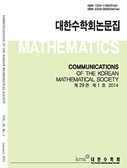Communications of the
Korean Mathematical Society
CKMS
Most Read
 VIEW ARTICLES
VIEW ARTICLES
 Most Read
Most Read
-
2023-10-31
The dimension of the maximal spectrum of some ring extensions
Rachida EL KHALFAOUI, Najib MahdouAbstract : Let $A$ be a ring and $\mathcal{J} = \{\text{ideals $I$ of $A$} \,|\, J(I) = I\}$. The Krull dimension of $A$, written $\dim A$, is the sup of the lengths of chains of prime ideals of $A$; whereas the dimension of the maximal spectrum, denoted by $\dim_\mathcal{J} A$, is the sup of the lengths of chains of prime ideals from $\mathcal{J}$. Then $\dim_{\mathcal{J}} A\leq \dim A$. In this paper, we will study the dimension of the maximal spectrum of some constructions of rings and we will be interested in the transfer of the property $J$-Noetherian to ring extensions.
-
2022-10-31
Circle approximation using parametric polynomial curves of high degree in explicit form
Young Joon AhnAbstract : In this paper we present a full circle approximation method using parametric polynomial curves with algebraic coefficients which are curvature continuous at both endpoints. Our method yields the $n$-th degree parametric polynomial curves which have a total number of $2n$ contacts with the full circle at both endpoints and the midpoint. The parametric polynomial approximants have algebraic coefficients involving rational numbers and radicals for degree higher than four. We obtain the exact Hausdorff distances between the circle and the approximation curves.
-
2023-07-31
S-coherent property in trivial extension and in amalgamated duplication
MOHAMED CHHITI, SALAH EDDINE MAHDOUAbstract : Bennis and El Hajoui have defined a (commutative unital) ring $R$ to be $S$-coherent if each finitely generated ideal of $R$ is a $S$-finitely presented $R$-module. Any coherent ring is an $S$-coherent ring. Several examples of $S$-coherent rings that are not coherent rings are obtained as byproducts of our study of the transfer of the $S$-coherent property to trivial ring extensions and amalgamated duplications.
-
2023-01-31
Numerical method for a system of Caputo fractional differential equations with non-local boundary conditions
S. Joe Christin Mary, Ayyadurai TamilselvanAbstract : A class of systems of Caputo fractional differential equations with integral boundary conditions is considered. A numerical method based on a finite difference scheme on a uniform mesh is proposed. Supremum norm is used to derive an error estimate which is of order $\kappa-1$, $1
-
2022-07-31
An improved global well-posedness result for the modified Zakharov equations in 1-D
Agus L. SoenjayaAbstract : The global well-posedness for the fourth-order modified Zakharov equations in 1-D, which is a system of PDE in two variables describing interactions between quantum Langmuir and quantum ion-acoustic waves is studied. In this paper, it is proven that the system is globally well-posed in $(u,n)in L^2 imes L^2$ by making use of Bourgain restriction norm method and $L^2$ conservation law in $u$, and controlling the growth of $n$ via appropriate estimates in the local theory. In particular, this improves on the well-posedness results for this system in cite{GZG} to lower regularity.
-
2022-07-31
New volume comparison with almost Ricci soliton
Shahroud azami, Sakineh HajiaghasiAbstract : In this paper we consider a condition on the Ricci curvature involving vector fields which enabled us to achieve new results for volume comparison and Laplacian comparison. These results in special case obtained with considering volume non-collapsing condition. Also, by applying this condition we get new results of volume comparison for almost Ricci solitons.
-
2022-07-31
Mean values of derivatives of quadratic prime Dirichlet $L$-functions in function fields
Hwanyup JungAbstract : In this paper, we establish an asymptotic formula for mean value of $L^{(k)}(frac{1}{2},chi_{P})$ averaging over $mb P_{2g+1}$ and over $mb P_{2g+2}$ as $g oinfty$ in odd characteristic. We also give an asymptotic formula for mean value of $L^{(k)}(frac{1}{2},chi_{u})$ averaging over $mc I_{g+1}$ and over $mc F_{g+1}$ as $g oinfty$ in even characteristic.
-
2022-10-31
On the semi-local convergence of contraharmonic-mean Newton's method (CHMN)
Ioannis K. Argyros, Manoj Kumar SinghAbstract : The main objective of this work is to investigate the study of the local and semi-local convergence of the contraharmonic-mean Newton's method (CHMN) for solving nonlinear equations in a Banach space. We have performed the semi-local convergence analysis by using generalized conditions. We examine the theoretical results by comparing the CHN method with the Newton's method and other third order methods by Weerakoon et al.~using some test functions. The theoretical and numerical results are also supported by the basins of attraction for a selected test function.
-
2023-01-31
The $u$-$S$-weak global dimensions of commutative rings
Xiaolei ZhangAbstract : In this paper, we introduce and study the $u$-$S$-weak global dimension $u$-$S$-w.gl.dim$(R)$ of a commutative ring $R$ for some multiplicative subset $S$ of $R$. Moreover, the $u$-$S$-weak global dimensions of factor rings and polynomial rings are investigated.
-
2022-10-31
Golden para-contact metric manifolds
Gherici Beldjilali, Habib BouzirAbstract : The purpose of the present paper is to introduce a new class of almost para-contact metric manifolds namely, Golden para-contact metric manifolds. Then, we are particularly interested in a more special type called Golden para-Sasakian manifolds, where we will study their fundamental properties and we present many examples which justify their study.

Most Read
-
Generalizing some Fibonacci--Lucas relations
Junghyun Hong, Jongmin Lee, Ho Park
Commun. Korean Math. Soc. 2023; 38(1): 89-96
https://doi.org/10.4134/CKMS.c220015 -
A translation of an analogue of Wiener space with its applications on their product spaces
Dong Hyun Cho
Commun. Korean Math. Soc. 2022; 37(3): 749-763
https://doi.org/10.4134/CKMS.c210264 -
Two linear polynomials shared by an entire function and its linear differential polynomials
Goutam Kumar Ghosh
Commun. Korean Math. Soc. 2023; 38(2): 377-387
https://doi.org/10.4134/CKMS.c210303 -
On graded $J$-ideals over graded rings
Tamem Al-Shorman, Malik Bataineh, Ece Yetkin Celikel
Commun. Korean Math. Soc. 2023; 38(2): 365-376
https://doi.org/10.4134/CKMS.c220169
Most Downloaded
-
Analytic functions with conic domains associated with certain generalized $q$-integral operator
OM P. AHUJA, Asena \c{C}etinkaya, NAVEEN KUMAR JAIN
Commun. Korean Math. Soc. 2023; 38(4): 1111-1126
https://doi.org/10.4134/CKMS.c230002 -
Transversal lightlike submersions from indefinite Sasakian manifolds onto lightlike manifolds
Shiv Sharma Shukla, Vipul Singh
Commun. Korean Math. Soc. 2023; 38(4): 1191-1213
https://doi.org/10.4134/CKMS.c220309 -
Generic lightlike submanifolds of semi-Riemannian product manifolds
Nand Kishor Jha, Jatinder Kaur, Sangeet Kumar, Megha Pruthi
Commun. Korean Math. Soc. 2023; 38(3): 847-863
https://doi.org/10.4134/CKMS.c220039 -
Equality in degrees of compactness: Schauder's theorem and $s$-numbers
Asuman Guven Aksoy, Daniel Akech Thiong
Commun. Korean Math. Soc. 2023; 38(4): 1127-1139
https://doi.org/10.4134/CKMS.c230003
Editorial Office
CKMS
© 2022. The Korean Mathematical Society. Powered by INFOrang Co., Ltd






